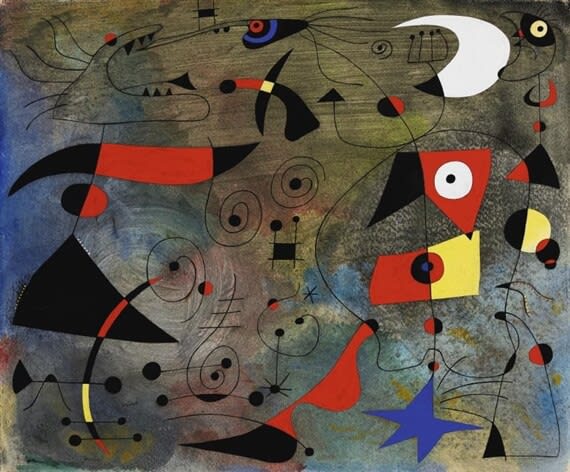When I was painting the Constellations I had the genuine feeling that I was working in secret. But it was a liberation for me…I ceased thinking about all the tragedy around me.”
In 1918, when Joan Miro was 25, he had his first exhibition in Barcelona. He had already been through some difficult times. His family wanted him to give up the idea of painting and focus on a more practical career in business. Bowing to their demands, he went to business school and worked in a clerical position for two years. The result was a deep depression, followed by a case of typhoid fever.
While convalescing at the family farm in Montroig, just outside of Barcelona, Miro made art. His first exhibit was a disaster. Not only was nothing sold, but critics ridiculed his work.
Miro didn’t give up his art…he went to Paris in 1920, met Picasso, Andre Masson and other dedicated artists, and returned to Montroig to make some of the most recognizable, unique and poignant works of art ever created.
Joan Miro in Perspective
The recent retrospective of Miro’s work at the Museum of Modern Art, was accompanied by a musical program put together by Miro’s grandson, Joan Punyet Miro. Punyet Miro manages his grandfather’s estate, assists the foundations that preserve and further Miro’s work and has spent own his adult life researching and writing about his grandfather’s life and work.
Joan Punyet remembers watching his grandfather work at home. “In the morning he worked in his studio;” he said in an interview in Germany’s Schirn Magazine, “I wasn’t allowed to visit him there. But after lunch he liked to read poetry, listen to music, and between seven and eight he sat on the couch and opened all his correspondence. And as soon as he had paper in his hand, he took his pen and I could see how he withdrew into himself, working and sketching. He was in the dining room, on his sofa, alone, in very dark light, and he would draw the whole time. I was next to him and saw how he drew these magnificent things. For me these represented some really special moments in my life, unforgettable.”
Much of Miro’s work is mystical, magical and joyful, yet it was created during times of turbulence and upheaval. Miro was born in 1893 and died in 1983. During his 90 years he experienced poverty, political unrest and a world at war.
During World War ll, Miro fled, with his wife a daughter, to Mallorca. “I was very pessimistic.” he said. “I felt that everything was lost.” But he continued to work, even in the darkest of times. “When I was painting the Constellations I had the genuine feeling that I was working in secret. But it was a liberation for me…I ceased thinking about all the tragedy around me.”
After the war, Miro’s work was exhibited around the world, including a show at MoMA, and he gained great acclaim. Femme et Oiseaux, one of the paintings in the Constellations series sold at Sotheby’s London in 2017 for 24,571,250 GBP, about $30.6 million.
Joan Miro’s Legacy
“It’s the young people who interest me, and not the old dodos.” Miro said, when he was 82. “If I go on working, it’s for the year 2000, and for the people of tomorrow.” Miro’s work continues to fascinate and inspire. Please contact us if you would like more information about the work of Joan Miro available at VFA.
Katharina Cichosch. It is Difficult to Be Miro’s Grandson. SCHIRN MAGAZINE. March 5, 2016.
Joseph Nechvatal. A Creative Colony of Modernists in Coastal France. Hyper allergic. May 27,2019.
Peter Schjeldahl. Joan Miró’s Modernism for Everybody. The New Yorker. March 4, 2019.




